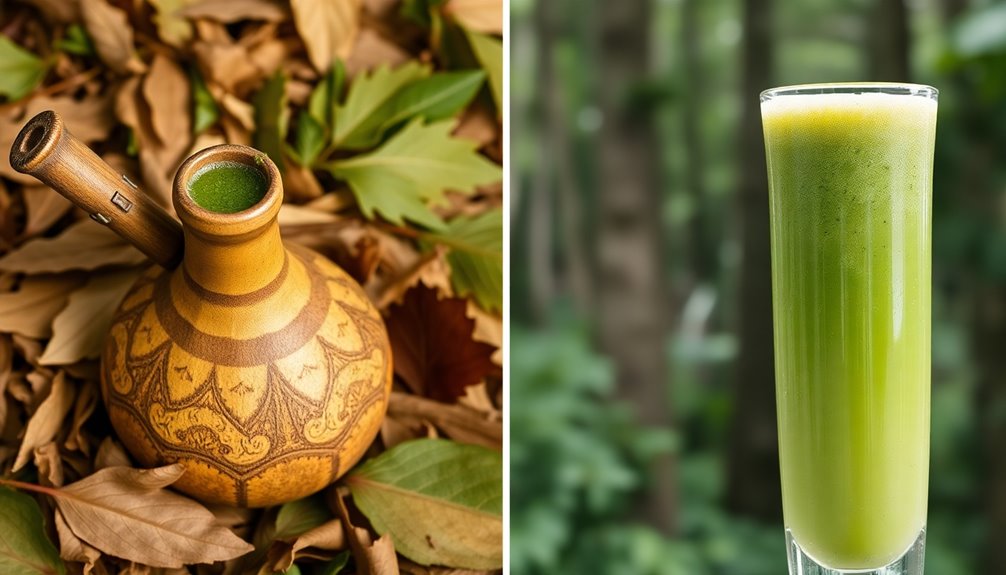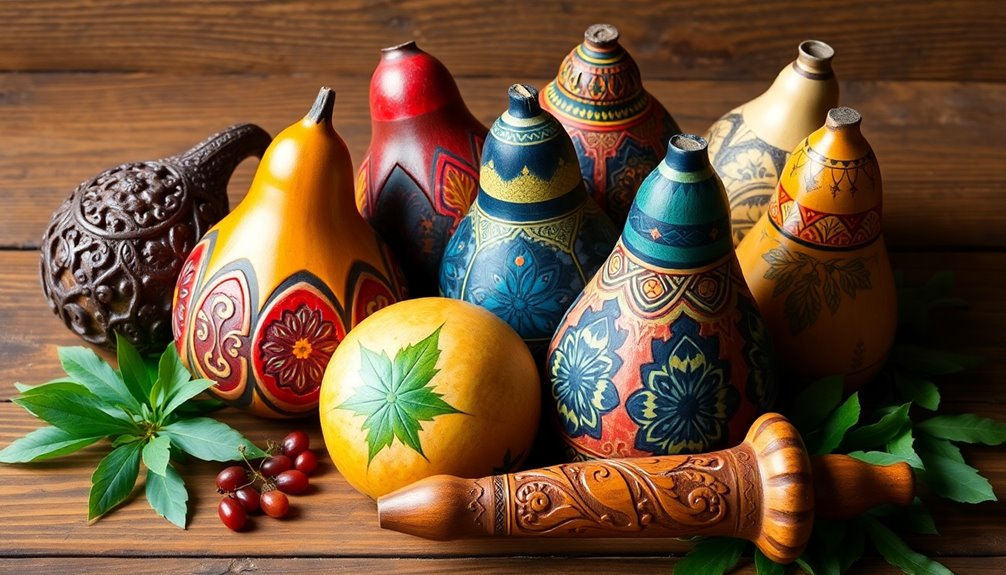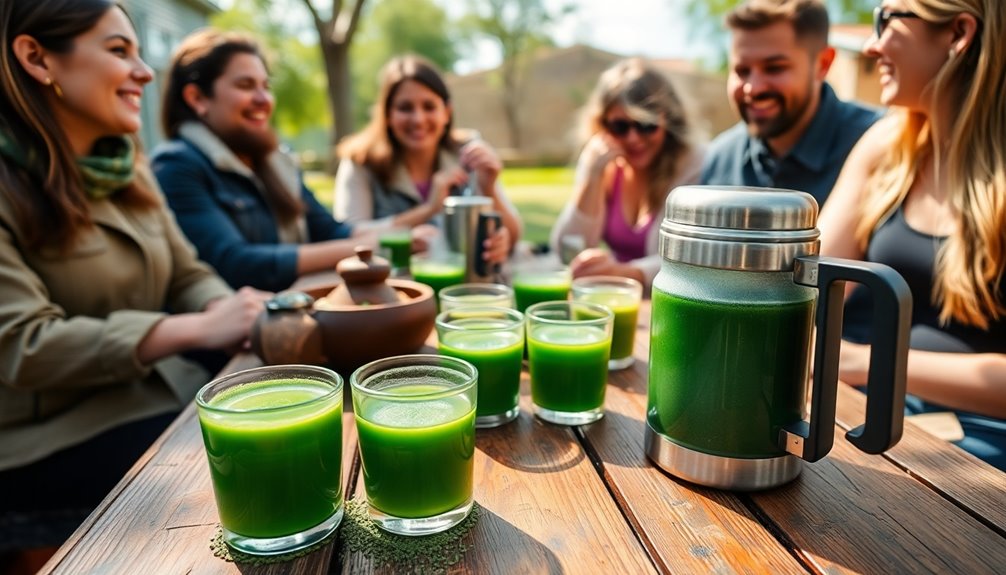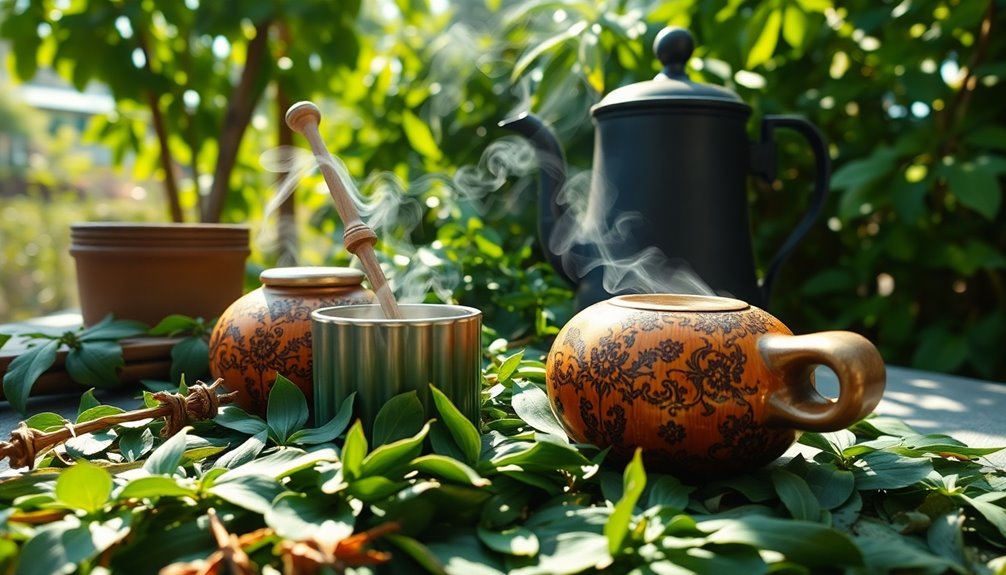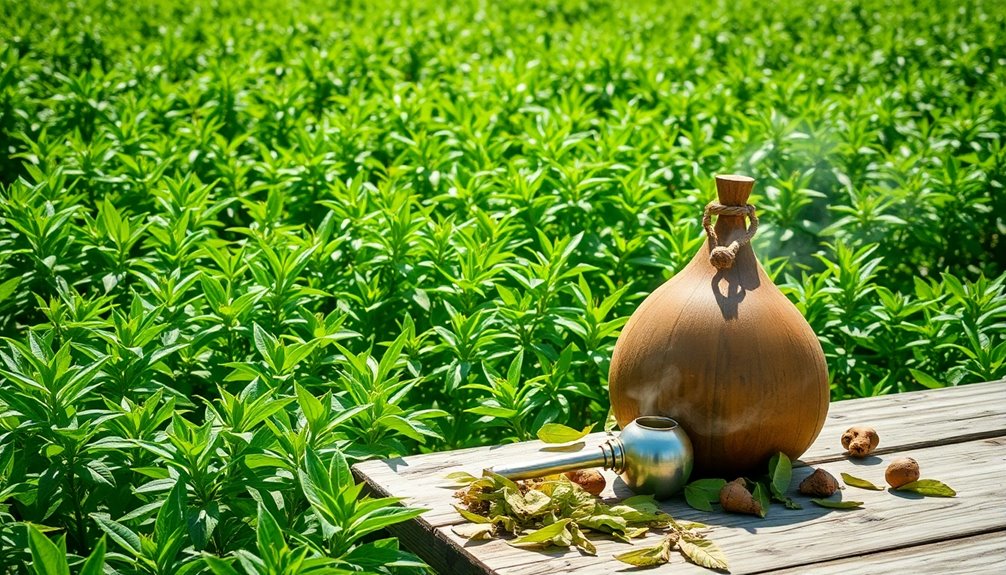Chimarrão is a special twist on traditional yerba mate that makes it super fun! Here's how they differ:
- Color & Texture: Chimarrão is a bright neon green, with a fine, powdery texture.
- Taste: It offers a fresher, smoother, and less bitter flavor.
- Leaf Ratio: Chimarrão has a higher leaf-to-stem ratio of about 85% leaves, giving it a longer-lasting taste.
- Preparation: You enjoy it in a bigger gourd called a cuia, perfect for sharing with friends!
These differences turn every sip into a refreshing experience. Stick around to uncover more exciting aspects!
Key Takeaways
- Chimarrão is made from finely ground leaves of the Ilex paraguariensis plant, resulting in a smoother, less bitter taste compared to traditional yerba mate.
- The unique grinding process of Chimarrão yields a fine, powdery texture, while traditional yerba mate is coarser and often includes a larger stem ratio.
- Chimarrão's higher leaf-to-stem ratio (85% leaves, 15% stems) enhances flavor longevity, unlike the stronger, bolder taste of traditional yerba mate.
- Preparation of Chimarrão requires a cuia and water at around 64ºC, while traditional yerba mate allows for a wider range of temperatures.
- Chimarrão is deeply rooted in Brazilian culture, emphasizing friendship and community, while traditional yerba mate rituals vary significantly across countries like Argentina and Uruguay.
Introduction
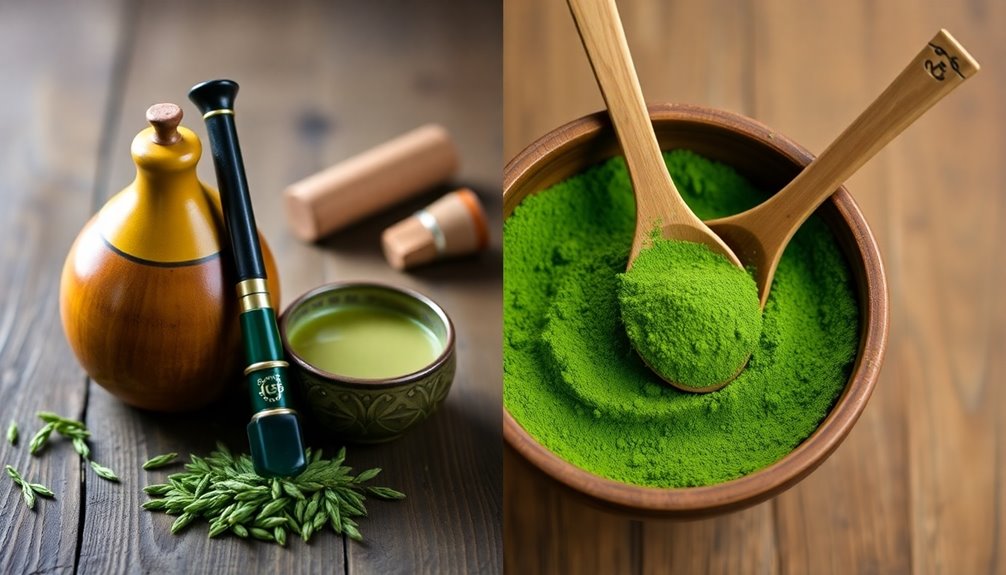
When you explore the world of yerba mate, you'll quickly notice that not all variants are created equal. One special type is Chimarrão, a Brazilian gem made from the Ilex paraguariensis plant. This unique drink boasts a bright neon green color and a fine, powdery texture.
Unlike traditional yerba mate, which can be darker and coarser, Chimarrão offers a fresher, smoother taste that many find delightful.
The preparation of Chimarrão is a fun experience! You'll use a cuia, which is a larger gourd, and a bombilla, a metal straw. It's important to use specific techniques to avoid clogging the straw, making it different from traditional mate methods.
Many people love Chimarrão because it's less bitter, making it a perfect introduction to the yerba mate culture.
With a higher leaf-to-stem ratio of about 85-15, this Brazilian yerba mate enhances flavor longevity, ensuring each sip is enjoyable.
Chimarrão's Distinct Grinding Process
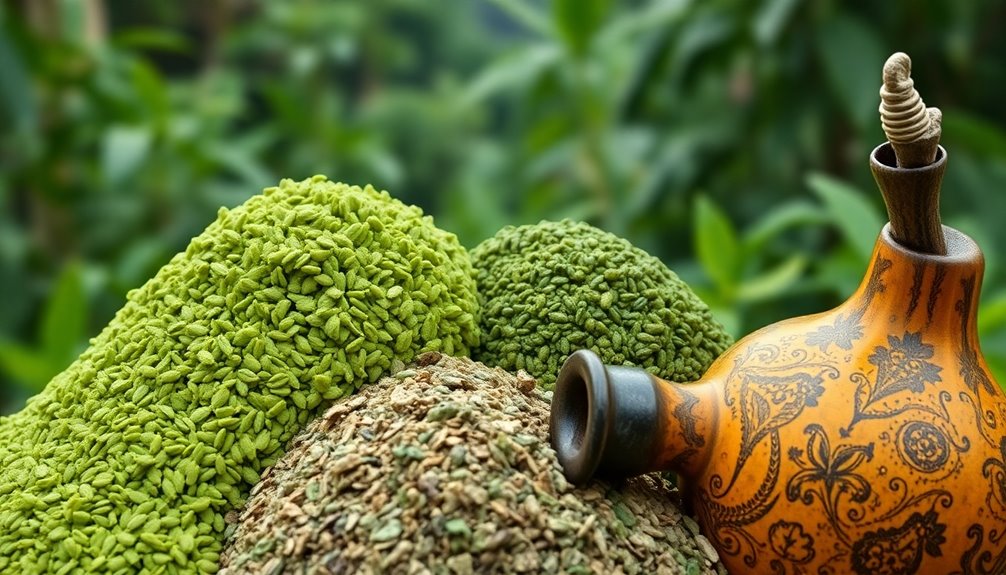
Chimarrão stands out not just for its unique taste but also for its distinct grinding process. When you're preparing chimarrão, the yerba mate is ground to a fine, powdery texture, similar to matcha. This special grinding technique helps enhance the flavor and creates a delightful drinking experience.
Unlike different types of yerba, chimarrão has about 85% leaves and only 15% stems. This higher leaf-to-stem ratio results in a milder and longer-lasting flavor, perfect for those just starting with yerba mate.
Plus, while traditional yerba mate often gets smoked during drying, chimarrão is dried without smoke, giving it a fresh, vibrant green look.
One of the coolest things about chimarrão is its bright neon color, which comes from quick packing right after harvest. This process keeps the levels of chlorophyll high, making it visually appealing.
Lastly, the distinct grinding and minimal aging lead to a less bitter taste, making chimarrão more approachable for everyone. So, next time you're sipping this delightful drink, you can appreciate the care that goes into making it!
Distinctive Brazilian Preparation Method
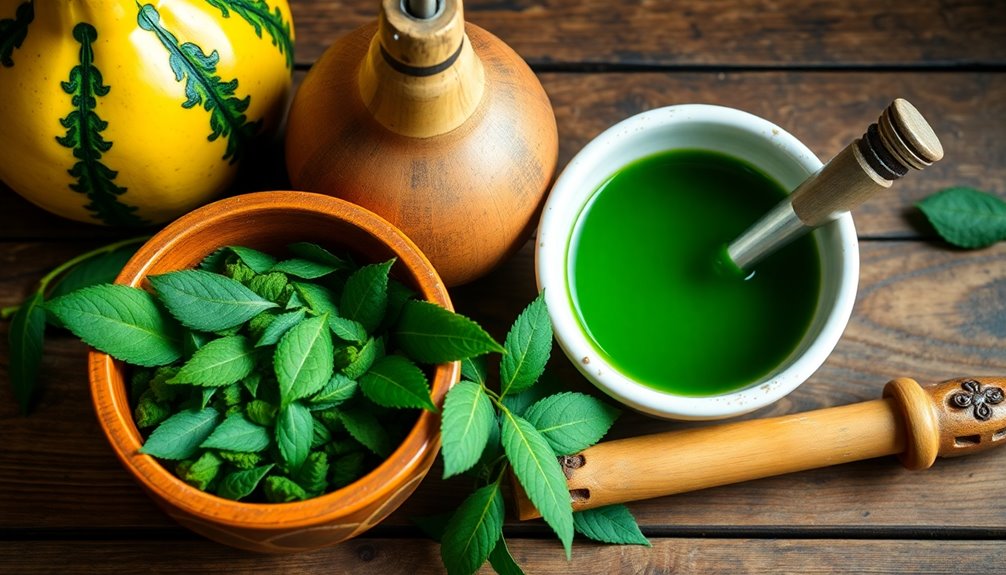
How do you prepare chimarrão to enjoy its unique flavors? First, grab a cuia, the special gourd that's larger and thicker than regular mate gourds.
You'll want to fill it with finely milled erva-mate, which is key for that fresh taste. Make sure you heat your water to about 64ºC. Using boiling water can ruin the flavor, so keep it cool!
Next, tilt the cuia to create a slope of erva-mate. This helps the leaves infuse properly and keeps the bombilla, or metal straw, from clogging.
Now, pour the hot water into the cuia, soaking the erva-mate.
The best part? Chimarrão is a communal drink! You can keep refreshing it by adding more hot water, inviting friends and family to join in the fun.
Everyone can take turns sipping from the bombilla, sharing stories and laughter.
Cultural Significance in Brazil
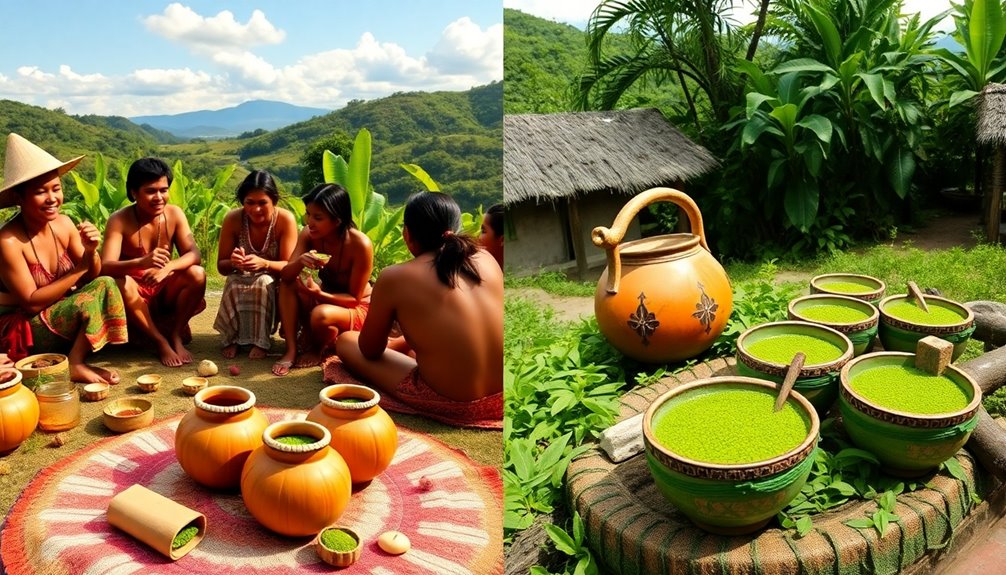
Although many beverages hold cultural significance, few resonate with the Brazilian people like chimarrão. This delightful drink goes beyond being just mate; it's a celebration of Brazilian culture! Originating from Indigenous Guarani traditions, chimarrão represents friendship and community. When you sip this warm beverage, you're joining a long-standing cultural practice that fosters social interaction among friends and family.
In southern Brazil, especially in the Gaúcho regions, chimarrão is a vital part of identity. The preparation and sharing of chimarrão come with special rituals. For example, you should always pass the gourd with your right hand and finish your drink before returning it. These simple acts show respect and keep traditions alive!
Chimarrão isn't just a drink; it's a way of life. It brings people together, creating bonds and memories. Whether you're at a family gathering or a festive celebration, sharing chimarrão makes every moment special.
Regional Flavor Preferences
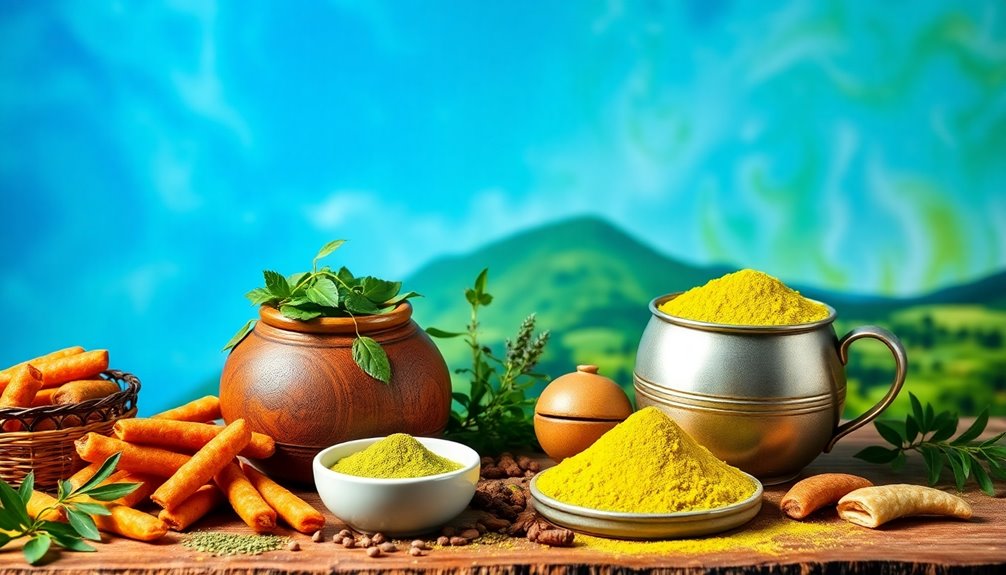
When comparing regional flavor preferences, you'll find that chimarrão and traditional yerba mate offer distinctly different taste experiences.
Chimarrão, made from Brazilian yerba mate, has a fresh, lighter flavor profile. It's smooth and buttery, making it perfect for those who are new to enjoying mate. In contrast, traditional yerba mate often has a stronger, bolder taste. This is because it's usually aged and sometimes even smoked, giving it a richer and more complex flavor.
Here are some key differences in flavor profiles:
- Chimarrão: Bright neon green, fresh, and smooth.
- Traditional Yerba Mate: Darker, coarser, and more robust, sometimes bitter.
In Brazil, especially in the southern regions, chimarrão is often enjoyed in a communal setting, which highlights the social aspect of sharing a milder drink with friends and family.
Meanwhile, traditional yerba mate rituals vary across countries like Argentina and Uruguay, reflecting their unique regional cultural traditions.
Practical Applications
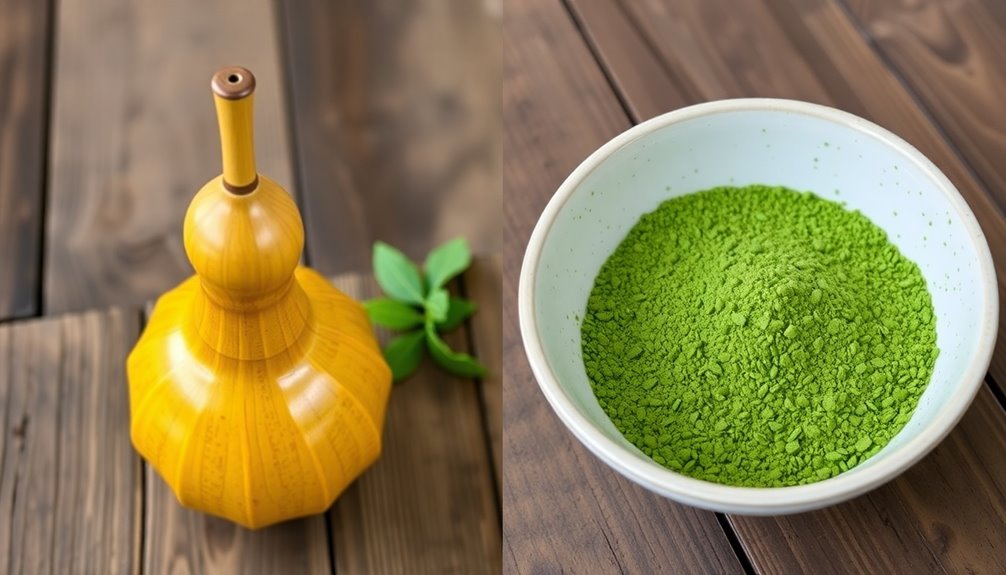
Chimarrão and traditional yerba mate each have practical applications that cater to different preferences and settings. If you're looking to prepare chimarrão, you'll enjoy its bright neon green color and smoother taste. It's perfect for those new to mate drinks, as it's less bitter than traditional yerba mate.
Here's how they differ in use:
- Flavor Profile: Chimarrão offers a gentler flavor, while traditional yerba mate packs a stronger punch.
- Preparation: To prepare chimarrão, you add hot water at 64ºC, which enhances its smoothness. Traditional yerba mate uses near-boiling water, creating a bolder taste.
- Cultural Rituals: Drinking chimarrão involves fun rituals like slurping and passing the gourd, making it a social experience. Traditional yerba mate has its own unique customs, adding variety to the experience.
Whether you're sharing chimarrão at a family gathering or enjoying traditional yerba mate with friends, both drinks bring joy and connection.
Each sip can spark delightful conversations and create cherished memories with fellow mate drinkers. So, grab your gourd and enjoy the warmth of these special drinks together!
Frequently Asked Questions
Is Chimarrão the Same as Yerba Mate?
No, chimarrão isn't the same as yerba mate. While both come from the same plant, they differ in preparation, flavor, and presentation, making each unique in its own right. You'll discover distinct experiences with both.
What Does Chimarrão Taste Like Compared to Yerba Mate?
When you try chimarrão, you'll notice its lighter, smoother, and fresher taste. Unlike yerba mate's earthy bitterness, chimarrão's flavor remains consistently mild and refreshing, making it a more approachable option for new drinkers.
Does Chimarrão Have More Caffeine?
Yes, chimarrão can have more caffeine than traditional yerba mate, especially due to its fresher leaves and higher leaf-to-stem ratio. You'll likely experience a stronger caffeine kick with chimarrão compared to some yerba mate preparations.
What Is the Difference Between Brazilian and Argentine Yerba Mate?
Brazilian yerba mate is brighter green, finely ground, and fresher due to a higher leaf-to-branch ratio. Argentine yerba mate, darker and coarser, offers a more complex flavor from aging and a balanced leaf-stem ratio.
Conclusion
In conclusion, chimarrão and traditional yerba mate each have their own special charm! With its unique grinding process and the fun way it's prepared, chimarrão brings a delightful twist to your sipping experience. It's more than just a drink; it's a joyful part of Brazilian culture. So, whether you're gathering with family or enjoying a quiet moment, trying chimarrão can add a splash of excitement to your day. Cheers to new flavors and traditions!

